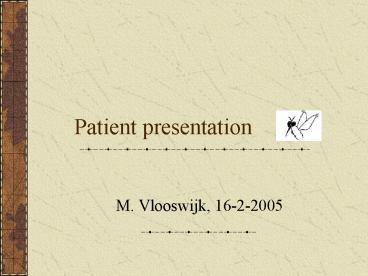Patient presentation - PowerPoint PPT Presentation
1 / 18
Title:
Patient presentation
Description:
... titers WNV , EMG: widespread axonal loss of motor axons of upper and lower limb ... CNS: posterior thalamus, basal ganglia, brainstem, spinal anterior horn cells ... – PowerPoint PPT presentation
Number of Views:33
Avg rating:3.0/5.0
Title: Patient presentation
1
Patient presentation
- M. Vlooswijk, 16-2-2005
2
Content
- Patient case and introduction
- Epidemiology
- Pathogenesis
- Clinical manifestations
- Diagnosis
- Treatment and prevention
- Prognosis
- Literature
3
Patient A.
- Man, 46 years. Medical history blank
- Symptoms sudden onset of myalgia, diffuse upper
and lower limb weakness, skin rash - During hospitalization respiratory failure,
prolonged ventilation and tracheostomy placement - Diagnostic tests CSF and blood titers WNV ,
EMG widespread axonal loss of motor axons of
upper and lower limb - Source Marciniak et.al. 2004
4
Patient A (II)
- No improvement on intravenous immunoglobulin G
- Complications tracheobronchitis, pneumonia,
Clostridium difficile infection and dysphagia
requiring gastrostomy tube - Total hospital stay 98 days
- Rest impairment after rehabilitation strength in
upper limbs 2/3, lower limbs 2/2 - Source Marciniak et.al. 2004
5
Epidemiology
- West Nile Virus, arbovirus, family Flaviviridae
- First described in 1937
- Sporadic outbreaks in Israel and Africa
- Mid-1990s outbreaks with severe neurologic
disease - First outbreak in North-America NYC 99
6
Human cases of WNV infection in the USA, 19992003
- Source Lancet
- Infect Dis 2004
7
Bird-mosquito-bird cycle
- SourceCenter for Disease
- Control and Prevention
8
- Other ways of transmission transfusion, organ
transplants, transplacental, breast milk,
percutaneous exposure in laboratory - 20 of infected persons develops mild illness
- One150 develops severe neurological illness
- Peak incidence August-September
- In temperate climates possibly all year
9
Pathogenesis
- Injection of virus-laden saliva
- Infection of fibroblasts, vascular endothelial
cells or cells of the RES ? viremia ?
inflammation BBB ? CNS infection - Predilection within CNS posterior thalamus,
basal ganglia, brainstem, spinal anterior horn
cells - Mechanisms of neuronal injury acute neuronal
necrosis, neuronophagia
10
Clinical manifestations
- Source www.publichealthgreybruce.on.ca
11
Clinical manifestations (II)
- Febrile illness West Nile fever
- Self-limited with fever, headache, malaise, back
pain, myalgia and anorexia. Rash in 50 - Neuro-invasive disease
- West Nile encephalitis
- West Nile meningitis
- Acute flaccid paralysis
- Complications
- Myocarditis, pancreatitis, hepatitis, ocular
complications
12
Neuro-invasive disease
- West Nile encephalitis
- Encephalopathy, evidence of CNS inflammation,
acute inflammation or demyelination on
neuroimaging, focal neurological deficit, EEG
consistent with encephalitis, seizures - West Nile meningitis
- Clinical signs of meningeal inflammation, acute
infection, acute meningeal inflammation on
neuroimaging - Acute flaccid paralysis
- Acute progressive limb weakness, asymmetry,
hyporeflexia, no pain/paraesthesias or numbness,
electrodiagnostic studies anterior-horn-cell
process, increased signal in anterior spinal grey
matter on MRI
13
Diagnosis
- To be considered in patients with unexplained
febrile illness, encephalitis and/or meningitis,
or flaccid paralysis, especially in summer or
early fall. History of travelling to the US - Lab
- White bloodcell count in serum normal or
elevated - CSF pleocytosis, predominance of lymphocytes,
elevated protein concentration
14
Diagnosis (II)
- Neuro-imaging
- CT no evidence of acute disease
- MRI 30 enhancement of leptomeninges and/or
periventricular areas, hyperintensity (T2) in
basal ganglia, thalami, caudate nuclei,
brainstem, spinal cord. - EEG generalized continuous slowing
- Electrodiagnostic studies
- Normal SNAPs
- Normal to markedly decreased CMAPs
15
Diagnosis (III)
- Serologic testing
- Detection of IgM antibody to WNV in serum or CSF,
eg with MAC-ELISA - When IgM in CSF, CNS infection is highly probable
- False-positive results recent vaccination with
yellow fever or Japanese encephalitis recent
infection with a related flavivirus (eg dengue)
16
Treatment and prevention
- Supportive treatment
- Trials
- iv immunoglobulin containing anti-WNV Ab
- IFN alfa-n3
- Avoid exposure to mosquitoes (DEET)
- Drainage of standing water
- Blood donor screening for WNV
- No human vaccines yet available
17
Prognosis
- Mortality rates (associated with advanced age)
- Encephalitis 12
- Meningitis 2
- Functional impairment
- Acute flaccid paralysis some improvement, no
recovery - Encephalitis difficulty walking, muscle
weakness, cognitive impairment
18
Literature
- Granwehr B.P. et.al. West Nile virus where are
we now? Lancet Infect Dis 2004 4 547-56 - Marciniak C. et.al. Acute flaccid paralysis
associated with West Nile virus motor and
functional improvement in 4 patients. Arch Phys
Med Rehabil 2004 85 1933-8 - Labowitz Klee A. et.al. Long-term prognosis for
clinical West Nile virus infection. Emerging
Infectious Diseases 2004 10 1405-11 - Petersen L.R. West Nile virus infection. UpToDate
2004































